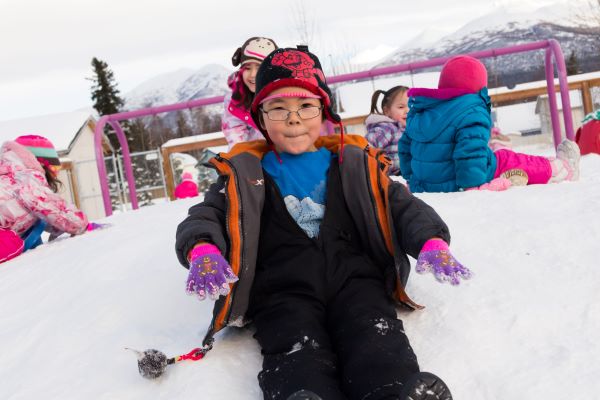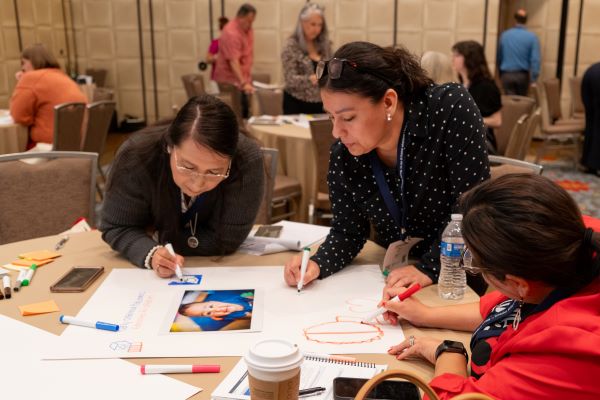Culturally sustaining programming challenges systemic, community, and personal biases, and teaches skills to foster belonging.
One challenge to understanding culture involves the way we acquire it. We are unaware of our own culture because our way of thinking and living, built up over a lifetime, has become a habit. Although all humans live within one or more cultures, our cultural knowledge is often subconscious.
Why It Matters

Biases can lead to prejudice and unfair treatment of children and families.These biases also impact who has — and importantly, who doesn’t have — equitable access to high-quality, inclusive early learning experiences.
- Structural and systemic racism creates inequities in health care access and quality care for historically marginalized communities. “The historically stigmatized racial groups, blacks (or African Americans), Native Americans (or American Indians and Alaska Natives) and Native Hawaiians and Other Pacific Islanders, have worse health than that of whites, and despite progress in reducing inequities over time, racial gaps in health persist.
- Educators committed to sustaining the developing cultural identity of young children must be aware of their own culture and how it influences their approach to teaching and engaging with families.
- Understanding culture requires ongoing reflective practice and recognition of the dangers of stereotyping. Reflective practices can also support individuals and help teams to use embodied practices to notice, name, and process the feelings and biased thinking or behaviors.
- The adultification bias of young Black children leads to unfair perceptions of these children as older than they are. As a result, they don’t receive the nurturing and protection they deserve.
- People with intersecting identities experience increased discrimination and bias. Research continues to highlight that children of color who have disabilities are among the most likely to be suspended or expelled.
- When starting group care, children may see cultures and languages that differ from their families for the first time. The interactions children and families have with staff can support or hinder children’s identities and their sense of belonging and acceptance of differences.
Connections to the HSPPS
In this section, learn about example indicators for this Multicultural Principle and how they are supported by the Head Start Program Performance Standards (HSPPS). Think about your program and your learning setting. Then, consider ways you already do these practices and ways you can more closely align to improve your practice.
| Example Indicators | Connections to the HSPPS |
|---|---|
Staff teach children how to build caring and inclusive learning communities. Staff help children to learn about their peers and respect individual differences. Staff genuinely discuss child’s strengths, interests, and needs with families. Gets information from families to use with child in curricular activities and daily routines. | Education and Child Development Services, 45 CFR §1302 Subpart C |
| Program leaders create opportunities for staff to think critically about inequities within and outside the program. | Personnel policies, 45 CFR §1302.90(c)(1) |
Example Indicators and Practical Strategies
Explore practical strategies drawn from research and Head Start programs that promote caring and inclusive learning communities.
Download the Try It! worksheet and choose one practice to focus on for one month. Use the prompts to thoughtfully plan how you will use the practice. The worksheet also includes tips for reflection after using the practice for one month.
Education staff teach children how to build caring learning communities.
 Creating a caring, equitable community of engaged and joyful learners requires staff to be aware of and address biases that influence their practice and interactions with children and families. It requires staff to embrace an equity-focused mindset, learn about individual children and family backgrounds and values, recognize discriminatory biases, and commit to high-quality, child-led, play-based approaches that equitably support children’s social and emotional well-being.
Creating a caring, equitable community of engaged and joyful learners requires staff to be aware of and address biases that influence their practice and interactions with children and families. It requires staff to embrace an equity-focused mindset, learn about individual children and family backgrounds and values, recognize discriminatory biases, and commit to high-quality, child-led, play-based approaches that equitably support children’s social and emotional well-being.
- Connect and build strong relationships with children to promote caring and a sense of belonging.
- Respond to children’s needs to establish trust. Children who experience adults that respond to their needs are more likely to do the same for their peers.
- Recognize caring behaviors shown by children. When children become aware and responsive to the needs of their peers, it creates a caring community of learners.
- Program leadership model and support staff to build and sustain caring and inclusive learning communities.
Education staff encourage children to learn about their peers and respect individual differences.
- Use multicultural and anti-bias frameworks to offer safe, inclusive spaces that represent all children and families. These approaches include having meaningful participation from families to make sure their cultural practices, languages, and values are honored in the learning environment.
- Help children embrace positive self-identities, respect differences, and learn about empathy and fairness.
- Model kindness and respect towards adults and children and teach children social skills and ways to solve problems fairly. Help them view situations from the perspectives of others through books, storytelling, and in-the-moment problem-solving.
- Demonstrate empathetic responses to help children learn to observe and respond to others with care.

Program leaders create opportunities for staff to think critically about inequities within and outside the program.
- Make time for honest discussions about signs of injustice and bias that staff observe to help staff respond and eliminate bias.
- Commit to embracing the tension that may arise when diverse identities, differing values and beliefs, or preferences are discussed. Avoiding this tension does not promote inclusion and belonging.
- Challenge staff to consider how dominant culture is prioritized through the materials and play experiences.
- Talk openly with staff and provide opportunities for them to learn how their cultural beliefs influence their expectations and actions with children and families.
- Use reflective supervision to give a protected, regularly occurring, collaborative, and reflective space for staff to share and address challenges that emerge in their work with children, families, and other program staff.
- Promote reflective practices that encourage and support staff in recognizing and addressing bias. Encourage staff use of mental health consultants to help to develop or facilitate communities of learning, which provide opportunities for self-reflection and peer-to-peer support in programs.
- Discuss how differences in culture influence planning and service delivery.
- How does culture influence planning for home visits and socialization groups?
- Are children and families empowered to share parts of their culture?
- During policy council meetings consider whose voices dominate the discussion.
- Which children receive services following a referral for special education services?
Practice Example: A coach from a Head Start program shared an example of addressing ageism bias in her organization. When a more seasoned staff member questioned the work of a younger teacher (or vice versa), the coach had individual conversations to understand each person’s perspective. The coach focused on discovering where the biases came from and how they impacted practice. The individual conversations with the teaching staff established trust between the coach and coachee. The coach then brought the teachers together to talk and find common ground. Their similar beliefs included their reason for teaching — being there for the children and families. As a result, the teachers could have collaborative teaching conversations with each other. Although such conversations can be uncomfortable, the coach shared that she has seen success when teachers talk openly.
Review program systems, policies, and procedures for bias and make changes as needed.
- Review systems, policies, and procedures to encourage fair access and engagement in program services.
- Find and remove barriers to ensure children and families are not at a disadvantage based on race, ethnicity, culture, language, ability, family composition, gender, or gender expansive identities.
- Use the BUILD Initiative Equity Action Framework, for example, to identify potential problems and possible solutions within four levels of change: personal, interpersonal, structural, and institutional.
Voices of the Head Start Community
 In this section, a Head Start agency with multiple sites shares how they organized a school readiness team to look at diversity and anti-bias practices in their programs.
In this section, a Head Start agency with multiple sites shares how they organized a school readiness team to look at diversity and anti-bias practices in their programs.
Use a checklist to intentionally examine personal and program biases.
A Head Start agency with multiple sites shared how they organized a school readiness team to look at diversity and anti-bias practices in their programs. One of the tools they tried was a checklist to help uncover known and unknown biases and how they might show up in the classroom. They made a checklist from various resources, such as the Head Start Program Performance Standards, 2008 Head Start Multicultural Principles, curricula used in their programs, and other checklists from the internet. The checklist they used encourages staff to do self-reflection, which has led them to talk about examining personal bias. This is the first step in ensuring anti-bias programming for children and families. The program’s family engagement specialist shared the importance of examining bias:
“Everyone has bias, you can’t not have it. It’s there, but [you need] to acknowledge it and to recognize it. The checklist does a little bit of that self-reflection and then you can work on it. Nobody’s perfect. Everyone has bias even when you don’t think that you do. That is what that checklist is all about."
Ask tough questions.
The agency let staff know that the checklist was meant to guide reflections and conversations and that it wouldn’t be used in a punitive way. The agency uses the checklist for all program services and classrooms.
The goal was to see where bias may exist by asking questions to encourage reflection. For example:
- During circle time and small group activities in which children are asked to answer open-ended questions, which children are redirected, and which children don’t participate?
- Can you experiment with using more gender expansive language when talking about occupations (people who fight fires, police officers, anyone can be a nurse)?
- Pay attention to whose behavior you single out in the classroom. Do you pay more attention to the Black boys’ behavior than the behavior of other children?
Talk about diversity, equity, and inclusion.
In addition to the checklist, the agency has invested in diversity training for all its staff. Training topics include culture, race, equity, and the LGBTQIA2S+ community. The agency knows that these trainings can be uncomfortable because they require people to examine and acknowledge their own bias. The family engagement specialist shared:
“We’ve learned that it’s uncomfortable for some people, but we believe that’s what you need to do to understand your biases. To understand other cultures is to ask questions, even if it comes across as a little ignorant, but if you are asking in a way where you want to learn, that is the environment that we want to create."
The trainings have helped staff feel more comfortable asking questions and sharing about their own culture. In addition, staff are encouraged to speak up and act when they see that something isn’t right. For example, the family engagement specialist shared a time when a staff member was eating food from her culture in the lunchroom and another staff member walked in and commented on the smell. This made the staff member who brought the food feel bad, and they asked the family engagement specialist what to do. The family engagement specialist encouraged her to talk to the person who commented and let her know how it made her feel. The family engagement specialist shared that these teachable moments can be incredible learning experiences. The staff from this agency talked about the importance of being honest with themselves when supporting families and staff from diverse backgrounds:
“You have to be honest with yourself. That is the first thing with anti-biases. If you are not honest with the things that irk you, then you can’t get past it or see it [your own biases]. You have to look at yourself before you can even begin to work in [early care and education]. Everyone has biases. It’s there but acknowledging them is the key."
Reflect
Early childhood programs can use the following questions as a starting point — to take a look at the challenges they face and the approaches they might use to promote culturally sustaining and equitable practice across service delivery areas. The questions listed below are designed for self-reflection and critical assessment of practice and can also be used with groups of staff, with families, and with community partners to spark dialogue. In order to go deeper into some topics in a group setting, programs may benefit from session leaders who are skilled facilitators either among their staff or from outside their program.
- How do you learn about each family’s values, beliefs, and approaches to their child’s growth and development?
- What opportunities does your program have for families and staff to share their beliefs, practices, and traditions?
- How can/does your program use reflective supervision and peer learning groups to promote anti-racist, inclusive, and equitable practice?
- Does your program offer coaching and professional development on the following subjects?
- Multicultural and anti-bias education approaches
- Child well-being and social and emotional development
Deepen Your Learning
Explore these useful resources to learn more about anti-bias approaches in your work with children and families.
- Anti-bias Teaching and Learning Environments in Head Start and Early Head Start Programs
- Build Initiative: Equity Action Framework
- Creating a Welcoming Early Childhood Program for LGBT-Headed Families
- Healthy Gender Development: A Guide for Early Childhood Professionals
- Resources and Strategies to Promote Anti-Bias Teaching and Home Visiting Practices
- Talking to Children About Differences and Similarities
Read more:
Resource Type: Article
National Centers: Early Childhood Development, Teaching and Learning
Audience: Directors and Managers
Last Updated: February 20, 2024